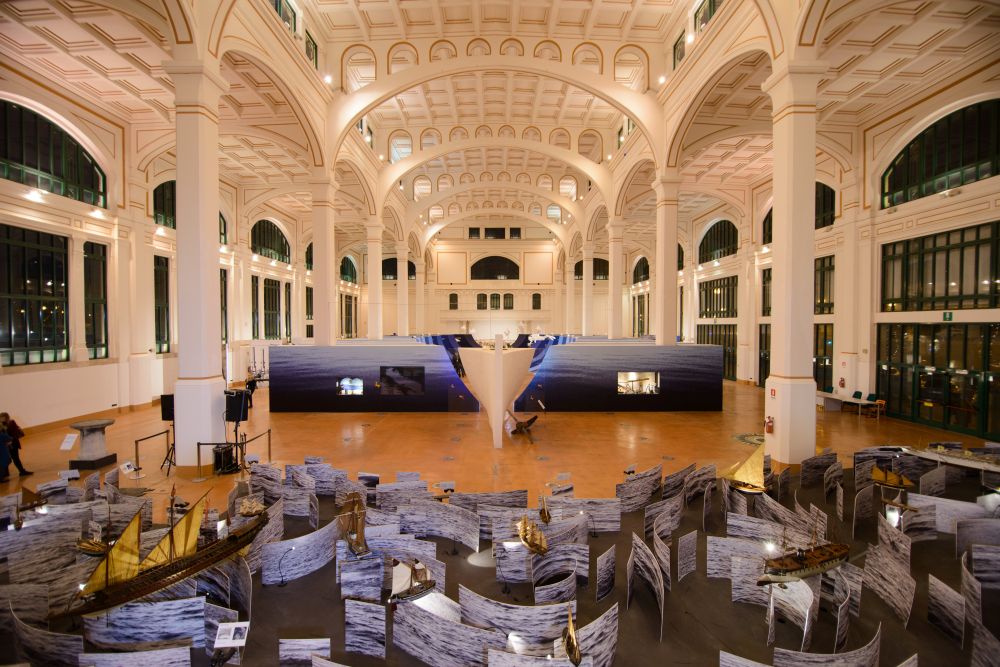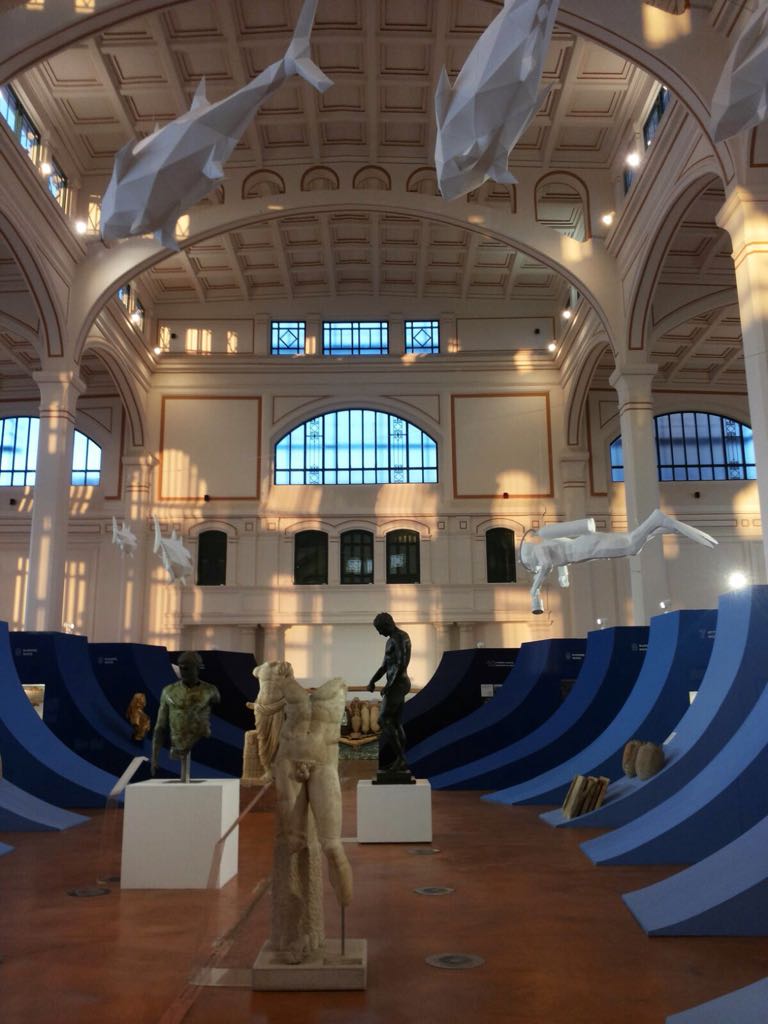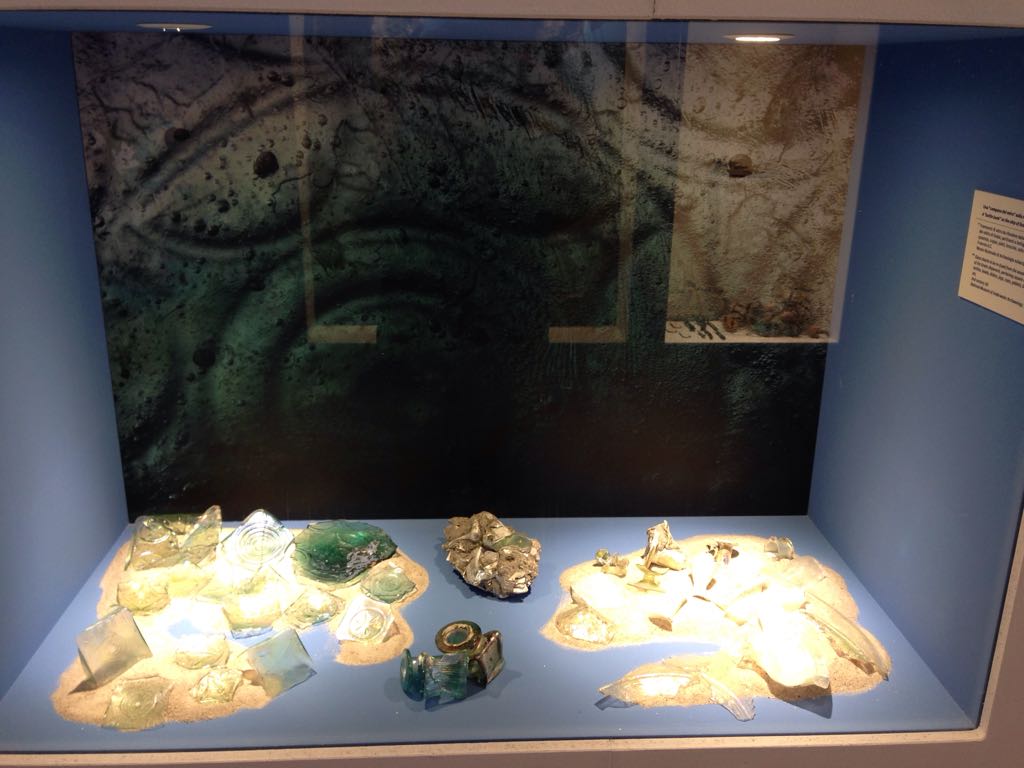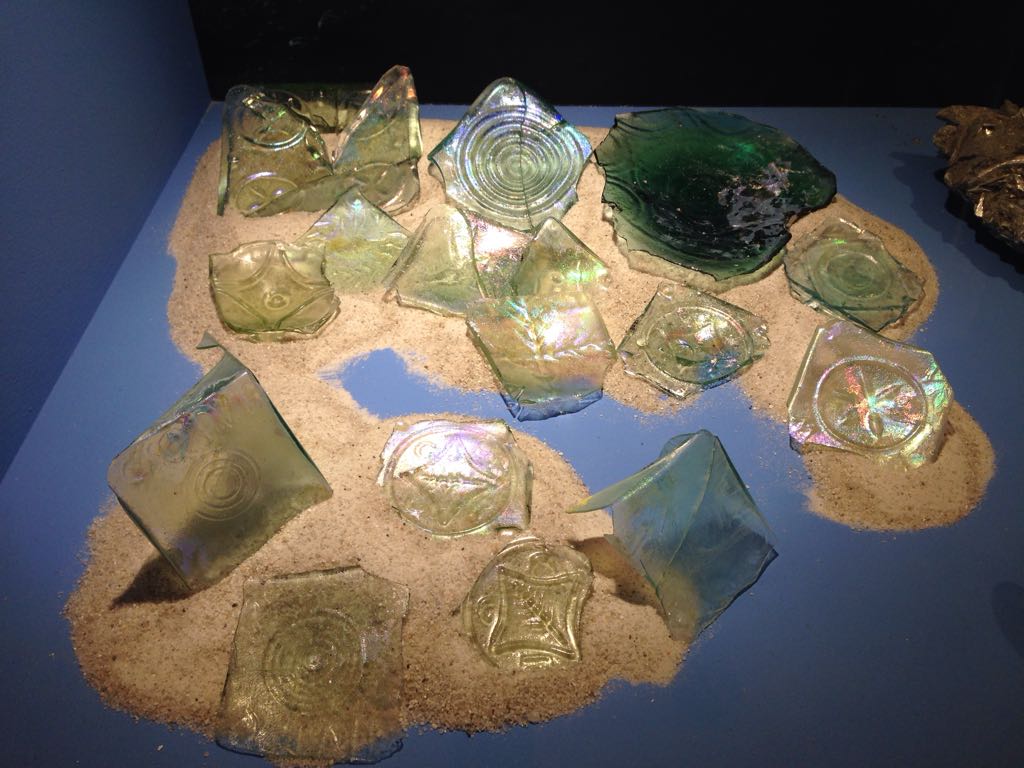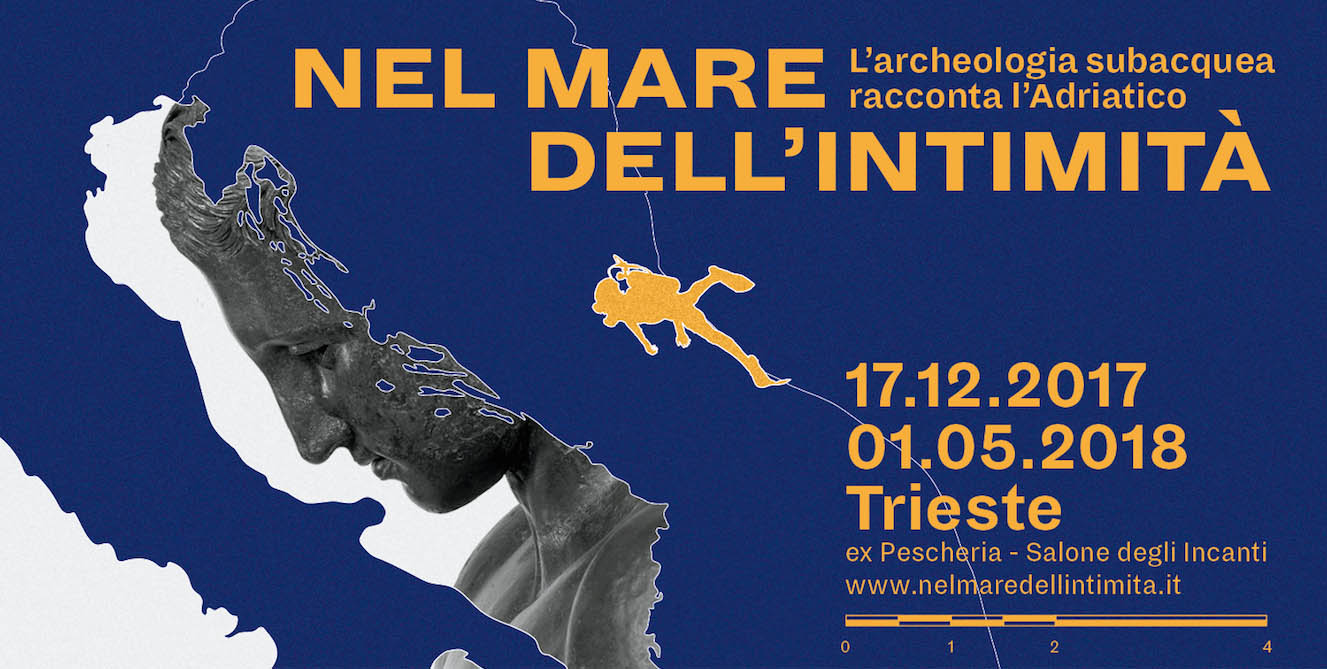The Adriatic, an ‘intimate’ sea, stretched between two long lines of coastline and open to different peoples and cultures. How many stories have crossed and overlapped over the centuries in its waters? how many men and women have looked at the Adriatic from a shore or from the bridge of a ship, or have invoked it to appease its rage or have ventured on it in search of favourable winds, exploits and fortune on ships pushed in flight by sails? In Trieste, an exhibition offers for the first time in an overview wrecks, works of art and objects of everyday life, goods and equipment on board: a thousand finds from submerged fields and lent by Italian, Slovenes, Croats and Montenegrins museums. Set up at the ex-Pescheria-Salone degli Incanti, from 17 December 2017 to 1 May 2018, the exhibition “In the sea of intimacy: underwater archaeology tells the Adriatic”, traces, thanks to the collaboration of over 60 Italian and international institutions and of 50 scholars, the extraordinary stories that emerge from the Adriatic sea.
The impressive setting-up of the exhibition, curated by Giovanni Panizon. (@ L. Mandruzzato)
Dedicated to the memory of Predrag Matvejević and his work Mediterranean: A Cultural Landscape in which he defined the Adriatic “Sea of intimacy”, the exhibition, curated by the ERPAC – Regional Body for Cultural Heritage of the Friuli Venezia Giulia Region together with the Municipality of Trieste and numerous others Italian and foreign institutional partners, allows to read, in over two thousand square meters of ‘water landscape’, cultural exchanges, trade, the dynamism of coastal landscapes, the stories of men who have crossed this intimate sea. Thanks to a spectacular setting, which reproduces the hull of a large ship lying on the seabed, the exhibition leads the visitor in a virtual, diachronic sailing through the centuries and the ever-changing coastal landscapes, through the ways and forms of ancient navigation, of relations, commerce, port and settlement along the shores of the Adriatic, from pre-Roman times to modern times. Through the traces of underwater archaeology and the finds that the sea itself held in its depths or along its banks, we can trace routes and crossings, along which we created a common language, a community and a strongly unitary identity.
Divided by themes, developed in the initial diaphragm and in the sections of the large ship, the exhibition, result of research projects and joint ventures, aims to stimulate reflection on the future of submerged heritage and underwater archaeology in Italy today.
The interior of the exhibition hull. (@ L. Mandruzzato)
Various aspects are then examined: from the representations that over the centuries the cartography has given of the Adriatic sea, to the harbours, landing places and piers that, since ancient times, have dotted its coasts: Ancona, Ravenna, Brindisi, and then Trieste, Pula, Split and many others. Following the trade routes, from one coast to the other, a network of maritime connections has always linked the various shores of the Adriatic, developing in the field of navigation a history of high technology and construction techniques evolved over time, as testified by the findings of naval archaeology: ancient merchant ships, galleons, vessels, Venetian rasconas and galleys and Ottoman ships, warships of the Italic Kingdom, and finally the submarines.
Navigation on the Adriatic has always been marked by trade, carrying all kind of goods: cereals, wine, oil, meat and fish, honey, glass, marble, metals, minerals, stones and bricks, precious pottery and artistic crafts, works of art, furniture and ornaments, ceramics, bronze, amber, gold, silver, ivory, precious stones, pearls, medicinal substances, incense, ointments, perfumes, leather, wool, silks and other fabrics, wood, slaves … But at the centre of all these activities there was a single great people who live on both sides of the sea, with many languages and cultures. Thanks to the archaeological finds emerged by the waters, admirals, sailors, traders, emperors, landowners, courtesans, pirates, slaves come back to life.
[one_half]
[/one_half]
[one_half_last]
[/one_half_last]
Glass findings. (@ L. Mandruzzato)
The Adriatic holds witness to fishing, the mother of all activities, practised throughout the ages. Fish is raised, fished and worked, but above all it is transported, alive and preserved, along with molluscs and shells.
But water, that holds people and places together, it is also a border: the Adriatic sea has always been a battleground to the peoples of an unborn Europe, the theatre of naval wars between East and West, the internal front against piracy. An area that has seen the change of peoples and territories, witnessing the ethnic and political fragmentations followed by the collapse of great Adriatic empires: Byzantine, Venetian, Austro-Hungarian, Ottoman, until the dissolution of the Yugoslavian Federation.
The Adriatic shores are punctuated with holy sites and resting places, essential reference points for navigation and for praying and thanking for surviving a shipwreck. But among its waters there is another thousands-year old story which seems never ending: the movement of enormous amounts of human beings across its shores, an incessant flux of wanderers, pilgrims, invaders, traders, fugitives.
A close web of human destinies travelling on luggers, Venetian pielagos and brazzeras, galleys, brigs, gulets, foists, galliots, ferries, rafts, patrol boats and NATO maritime units whose stories still prompt us today to think about concepts like individual and social identity and immigration policies. Finally, the exhibition illustrates the methods of underwater archaeological research that allow us to understand the complexity of a profession based on research and passion for discovery and restoration of lost heritages.
https://www.nelmaredellintimita.it/
“Nel mare dell’intimità”, the logo of exhibition.
Head Image: Entrance of the exhibition. (@ L. Mandruzzato)
L’Adriatico, mare dell’intimità
L’Adriatico, un mare ‘intimo’, stretto tra due lunghe linee di costa e aperto a genti e culture diverse. Quante storie si sono incrociate e sovrapposte nel corso dei secoli tra le sue acque? quanti uomini e donne hanno guardato l’Adriatico da una riva o dal ponte di una nave, o lo hanno invocato per placarne le furie o su di esso si sono avventurati alla ricerca di venti propizi, imprese e fortuna su navi spinte in volo dalle vele? A Trieste, una mostra offre per la prima volta in una visione di insieme relitti, opere d’arte e oggetti della vita quotidiana, merci e attrezzature di bordo: un migliaio di reperti provenienti dai giacimenti sommersi e prestati per l’occasione da musei italiani, sloveni, croati e montenegrini. Allestita all’ex-Pescheria-Salone degli Incanti, dal 17 dicembre 2017 al 1 maggio 2018, la mostra “Nel mare dell’intimità. L’Archeologia subacquea racconta l’Adriatico” ripercorre, grazie alla collaborazione di oltre 60 istituzioni italiane e internazionali e di 50 studiosi, le straordinarie storie che emergono dal mare Adriatico.
Lo scenografico allestimento della mostra curato dall’arch. Giovanni Panizon. (@ L. Mandruzzato)
Dedicata alla memoria di Predrag Matvejević e alla sua opera Breviario Mediterraneo nel quale definiva l’Adriatico ‘mare dell’intimità’, e curata dall’ERPAC – Ente Regionale per il Patrimonio Culturale della Regione Friuli Venezia Giulia insieme al Comune di Trieste e a numerosi altri partner istituzionali italiani e stranieri, l’esposizione, permette di leggere, in oltre duemila metri quadri, trasformati per l’occasione in un paesaggio d’acqua, gli scambi culturali, i commerci, il dinamismo dei paesaggi costieri, le storie degli uomini che hanno solcato questo mare intimo. Grazie ad un allestimento spettacolare, che riproduce la carena di una grande nave adagiata sul fondale, l’esposizione conduce il visitatore in una virtuale, diacronica veleggiata attraverso i secoli e i paesaggi costieri in continua evoluzione, attraverso i modi e le forme della navigazione antica, delle relazioni, del commercio, della portualità e dell’insediamento lungo le sponde dell’Adriatico, dall’età preromana all’epoca moderna. Attraverso le tracce dell’archeologia subacquea e dei reperti che il mare stesso custodiva nei suoi fondali o lungo le rive, si ripercorrono rotte e traversate, lungo le quali si sono create una lingua comune, una comunità e un’identità fortemente unitaria. Suddivisa per temi, sviluppati nel diaframma iniziale e nei setti della grande nave, la mostra, esito di progetti di ricerca e di joint venture, vuole sollecitare la riflessione sul futuro del patrimonio sommerso e sull’archeologia subacquea oggi in Italia.
L’interno della carena allestitiva. (@ L. Mandruzzato)
Passano in rassegna quindi diversi aspetti: dalle rappresentazioni che nei secoli la cartografia ha dato dell’Adriatico ai porti, agli approdi e agli imbarcaderi che, fin dall’antichità, hanno punteggiato le coste dell’Adriatico: Ancona, Ravenna, Brindisi, e poi Trieste, Pola, Spalato e molte altri. Seguendo le rotte commerciali, da una costa all’altra, una rete di connessioni marittime ha da sempre collegato le varie sponde dell’Adriatico, sviluppando nel campo della navigazione una storia di alta tecnologia e di tecniche costruttive che evolvono nel tempo, come testimoniano i ritrovamenti dell’archeologia navale: imbarcazioni mercantili dell’Antichità, galeoni, vascelli, rascone, galee veneziane e navi ottomane, navi militari del Regno Italico, e infine i sommergibili.
Il commercio segna da sempre la navigazione sull’Adriatico, trasportando di tutto: cereali, vino, olio, carne e pesce, miele, vetro, marmo, metalli, minerali, pietre e laterizi, vasellame pregiato e artigianato artistico, opere d’arte, arredi e ornamenti, ceramica, bronzo, ambra, oro, argento, avorio, pietre preziose, perle, sostanze medicinali, incensi, unguenti, profumi, pellami, cuoio, lana, sete e altri tessuti, legname, schiavi… Ma al centro di tutte queste attività c’è un unico grande popolo che abita le due sponde del mare, dalle tante lingue e culture. Grazie ai reperti archeologici riaffiorati dalle acque, rivivono ammiragli, marinai, commercianti, imperatori, latifondisti, cortigiane, pirati, schiavi
Reperti di vetro. (@ L. Mandruzzato)
L’attività “madre”, praticata in tutte le epoche, di cui l’Adriatico serba memoria dalle età più antiche, è la pesca. Il pesce si alleva, si pesca e lavora, ma soprattutto si trasporta, vivo e conservato, insieme a molluschi e alle conchiglie.
Ma l’acqua che unisce è anche frontiera: da sempre, l’Adriatico è terreno di scontro per i popoli di un’Europa in gestazione, teatro di guerre navali fra Oriente e Occidente, fronte interno contro la pirateria. Un’area che ha visto mutare popoli e territori, testimone delle frammentazioni etniche e politiche seguite al crollo dei grandi imperi adriatici: bizantino, veneziano, austro-ungarico, ottomano, fino alla dissoluzione della Federazione jugoslava.
Le sponde adriatiche sono punteggiate di luoghi dedicati al “sacro” e alla sosta, punti di riferimento essenziali per la navigazione e per pregare e ringraziare per il naufragio scampato.
L’Adriatico è anche protagonista di un’altra storia millenaria che sembra non avere fine: lo spostarsi di enormi quantità di esseri umani fra le sue sponde, in un movimento incessante di peregrinazioni, pellegrinaggi, invasioni, commerci, fughe. Una fitta trama di destini umani ha viaggiato su trabaccoli, pieleghi, brazzere, galere, brigantini, caicchi, fuste, galeotte, traghetti, gommoni, motovedette, unità della NATO, in un racconto che ancora oggi chiama alla riflessione sui concetti di identità, appartenenza e accoglienza.
Infine, la mostra illustra le metodologie della ricerca archeologica subacquea che permettono di capire la complessità di una professione, che ha il suo fondamento nella ricerca e nella passione per la scoperta e la restituzione di patrimoni perduti.
“Nel mare dell’intimità”, il logo della mostra.
Head Image: Ingresso della mostra. (@ L. Mandruzzato)
